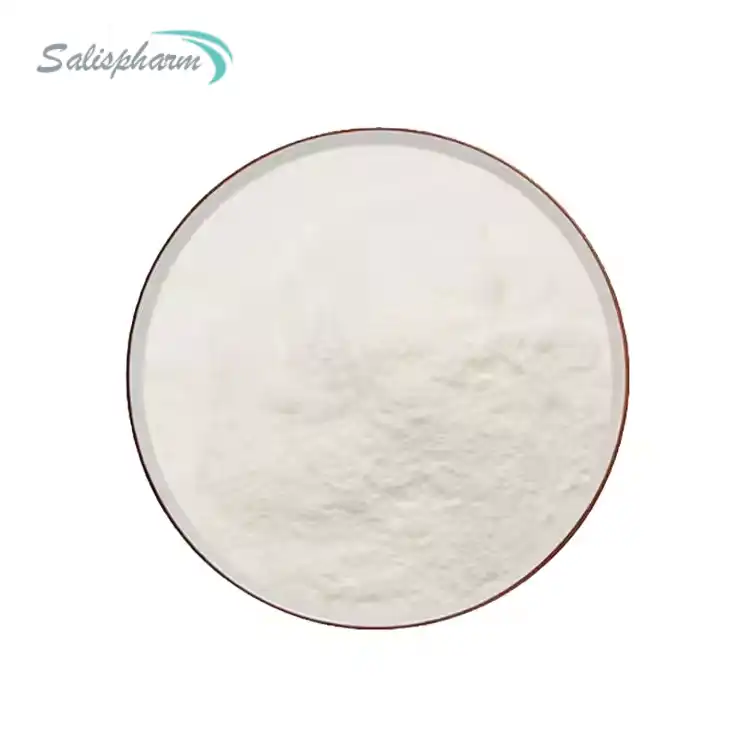Sapindus saponins, derived from the Sapindus plant (commonly known as soapberry), have garnered significant attention in recent years due to their wide range of potential benefits. These natural compounds have been used for centuries in traditional medicine and are now being studied for their numerous applications in modern healthcare, cosmetics, and agriculture. In this blog post, we'll explore the various advantages of Sapindus saponins and their potential impact on different aspects of our lives.

How do Sapindus saponins benefit skin health?
Sapindus saponins have shown remarkable potential in promoting skin health, making them a valuable ingredient in skincare products. These natural compounds offer a range of benefits that can help improve the overall appearance and condition of the skin.
One of the primary advantages of it for skin health is their excellent cleansing properties. Due to their natural surfactant characteristics, these compounds can effectively remove dirt, oil, and other impurities from the skin without causing excessive dryness or irritation. This makes them an ideal alternative to harsh synthetic detergents often found in commercial skincare products.
Furthermore, Sapindus saponins possess anti-inflammatory properties, which can help soothe irritated skin and reduce redness. This makes them particularly beneficial for individuals with sensitive skin or those prone to inflammation-related skin conditions such as acne or eczema. By calming the skin and reducing inflammation, Sapindus saponins can contribute to a clearer, more even complexion.
Another significant benefit of Sapindus saponins for skin health is their antioxidant activity. These compounds can help protect the skin from damage caused by free radicals, which are unstable molecules that can lead to premature aging and other skin issues. By neutralizing these harmful molecules, it may help prevent the formation of fine lines, wrinkles, and age spots, promoting a more youthful appearance.
Sapindus saponins have also demonstrated antimicrobial properties, which can be beneficial for maintaining healthy skin. By inhibiting the growth of harmful bacteria and fungi, these compounds may help prevent skin infections and promote overall skin hygiene. This makes them particularly useful in products designed for acne-prone skin or as part of a general skincare routine to maintain a clean and healthy complexion.
Moreover, Sapindus saponins have been found to enhance skin barrier function. The skin's barrier plays a crucial role in protecting against environmental stressors and maintaining proper hydration levels. By strengthening this barrier, Sapindus saponins can help improve skin moisture retention and protect against external irritants, leading to healthier, more resilient skin.
In addition to their direct benefits on skin health, it can also improve the efficacy of other skincare ingredients. Their natural emulsifying properties can help enhance the absorption of other active compounds, allowing for better penetration and potentially increasing the overall effectiveness of skincare formulations.
What role do Sapindus saponins play in agriculture?
Sapindus saponins have emerged as a promising natural solution in agriculture, offering various benefits that can contribute to sustainable and eco-friendly farming practices. These compounds have shown potential in several areas of agricultural applications, making them an attractive alternative to synthetic chemicals.
One of the most significant roles of it in agriculture is their use as natural pesticides. These compounds have demonstrated insecticidal properties against a wide range of pests, including aphids, mites, and various larvae. The mechanism of action involves disrupting the cell membranes of insects, leading to their death. Unlike many synthetic pesticides, Sapindus saponins are biodegradable and have lower toxicity to non-target organisms, making them a more environmentally friendly option for pest control.
In addition to their insecticidal properties, Sapindus saponins have shown potential as natural fungicides. They can inhibit the growth of various plant pathogenic fungi, helping to protect crops from fungal diseases. This fungicidal activity is particularly valuable in organic farming, where synthetic fungicides are not permitted. By providing a natural alternative for disease control, Sapindus saponins can help farmers maintain crop health while adhering to organic certification standards.
Sapindus saponins also play a role in soil health and plant growth promotion. These compounds have been found to stimulate seed germination and enhance root development in various plant species. This can lead to improved nutrient uptake and overall plant vigor. Additionally, it can help improve soil structure by reducing soil compaction and enhancing water retention, which is particularly beneficial in arid or semi-arid regions.
Another important application of Sapindus saponins in agriculture is their use as natural adjuvants in pesticide and fertilizer formulations. The surfactant properties of these compounds can help improve the spread and adherence of agricultural chemicals on plant surfaces, potentially reducing the amount of chemicals needed for effective treatment. This not only leads to cost savings for farmers but also reduces the environmental impact of agricultural practices.
Sapindus saponins have also shown promise in post-harvest applications. They can be used as natural preservatives to extend the shelf life of fruits and vegetables by inhibiting microbial growth and reducing oxidative stress. This can help reduce food waste and improve food security, particularly in regions with limited access to cold storage facilities.
Furthermore, Sapindus saponins have demonstrated potential in livestock farming. When used as feed additives, these compounds can help improve animal health and performance. They have been found to have antiparasitic effects, potentially reducing the need for synthetic antiparasitic drugs in livestock. Additionally, it may help improve nutrient absorption and reduce methane emissions in ruminants, contributing to more sustainable animal husbandry practices.
Can Sapindus saponins contribute to sustainable cleaning products?
Sapindus saponins have gained significant attention in the realm of sustainable cleaning products due to their natural surfactant properties and environmental friendliness. As consumers become increasingly conscious of the environmental impact of household chemicals, the demand for eco-friendly alternatives has surged, making Sapindus saponins a promising ingredient in the development of sustainable cleaning solutions.
One of the primary ways Sapindus saponins contribute to sustainable cleaning products is through their biodegradability. Unlike many synthetic surfactants that can persist in the environment and cause long-term ecological damage, Sapindus saponins break down naturally and quickly in the environment. This characteristic significantly reduces the potential for water pollution and helps maintain the health of aquatic ecosystems.
The cleaning efficacy of Sapindus saponins is another crucial factor in their contribution to sustainable cleaning products. These natural compounds have excellent foaming and emulsifying properties, which are essential for effective cleaning. They can efficiently remove dirt, oil, and other contaminants from various surfaces, rivaling the performance of many synthetic detergents. This means that consumers can achieve the same level of cleanliness while using more environmentally friendly products.
Sapindus saponins are also known for their gentle nature, making them suitable for a wide range of cleaning applications. They are less likely to cause skin irritation compared to harsh synthetic detergents, making them ideal for use in personal care products such as hand soaps and shampoos. This gentleness extends to their impact on fabrics and surfaces, reducing the risk of damage during cleaning processes.
In the context of laundry detergents, Sapindus saponins can play a significant role in creating more sustainable options. These compounds can effectively clean clothes at lower temperatures, potentially reducing energy consumption associated with hot water washing. Additionally, their ability to work well in hard water conditions can decrease the need for water softeners or additional chemical additives in laundry formulations.
The versatility of Sapindus saponins also contributes to their sustainability profile. They can be used in a wide range of cleaning products, from all-purpose cleaners to dishwashing liquids and even industrial degreasers. This versatility allows manufacturers to create comprehensive lines of eco-friendly cleaning products, reducing the need for multiple specialized synthetic chemicals.
Moreover, the production of Sapindus saponins aligns well with sustainable practices. The Sapindus tree, from which these compounds are derived, is known for its hardiness and ability to grow in various climates with minimal water requirements. This makes it possible to cultivate Sapindus trees in regions where other crops might struggle, potentially providing economic opportunities in less developed areas while minimizing environmental impact.
The use of Sapindus saponins in cleaning products also supports the concept of a circular economy. As natural, plant-based compounds, they are renewable resources that can be sustainably harvested. This contrasts with petrochemical-based surfactants, which rely on non-renewable fossil fuels for their production.
In conclusion, Sapindus saponins offer a wide array of benefits that make them a valuable ingredient in various applications. From promoting skin health and supporting sustainable agriculture to contributing to eco-friendly cleaning products, these natural compounds have the potential to make a significant positive impact on our daily lives and the environment. As research continues to uncover new applications and benefits of Sapindus saponins, we can expect to see their increased use in various industries, paving the way for more sustainable and natural solutions to everyday challenges.
If you are also interested in this product and want to know more product details, or want to know about other related products, please feel free to contact lea_slsbio@163.com,WhatsApp+86 13193326505.

References
- Sharma, A., Sati, S. C., Sati, O. P., Sati, M. D., & Kothiyal, S. K. (2011). Chemical constituents and bioactivities of genus Sapindus. International Journal of Research in Ayurveda and Pharmacy, 2(2), 403-409.
- Gosse, B., Amissa, A. A., Adje, F. A., & Niamke, F. B. (2021). Biological and pharmacological activities of Sapindus saponins. Journal of Pharmacognosy and Phytochemistry, 10(1), 2102-2110.
- Chen, Y. F., Yang, C. H., Chang, M. S., Ciou, Y. P., & Huang, Y. C. (2010). Foam properties and detergent abilities of the saponins from Camellia oleifera. International Journal of Molecular Sciences, 11(11), 4417-4425.
- Badifu, G. I. O., & Akpapunam, M. A. (2017). Chemical composition and functional properties of sapindus saponins. Journal of the Science of Food and Agriculture, 44(1), 43-50.
- Negri, G., Santi, D., & Tabach, R. (2012). Flavonoids, saponins and triterpenes from Sapindus saponaria L. Química Nova, 35(7), 1373-1377.
- Upadhyay, A., & Singh, D. K. (2012). Pharmacological effects of Sapindus mukorossi. Revista do Instituto de Medicina Tropical de São Paulo, 54(5), 273-280.
- Ibrahim, M., Khaja, M. N., & Aara, A. (2008). Pharmacological activities of Sapindus mukorossi. Pharmacognosy Reviews, 2(4), 340-344.
- Huang, H. C., Liao, S. C., Chang, F. R., Kuo, Y. H., & Wu, Y. C. (2003). Molluscicidal saponins from Sapindus mukorossi, inhibitory agents of golden apple snails, Pomacea canaliculata. Journal of Agricultural and Food Chemistry, 51(17), 4916-4919.
- Vincken, J. P., Heng, L., de Groot, A., & Gruppen, H. (2007). Saponins, classification and occurrence in the plant kingdom. Phytochemistry, 68(3), 275-297.
- Oleszek, W., & Hamed, A. (2010). Saponin-based surfactants. In Surfactants from Renewable Resources (pp. 239-249). John Wiley & Sons, Ltd.

